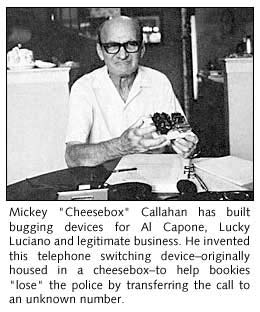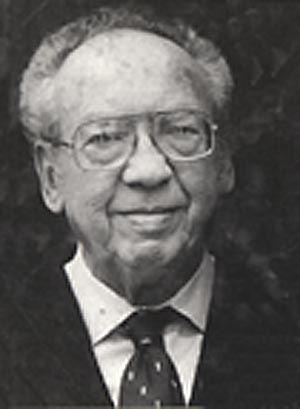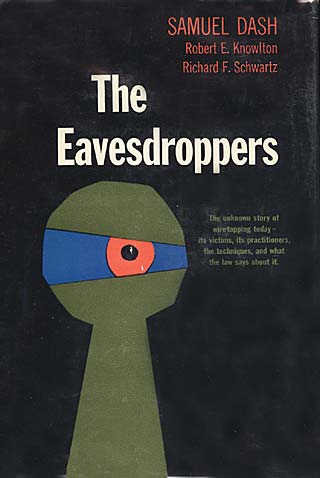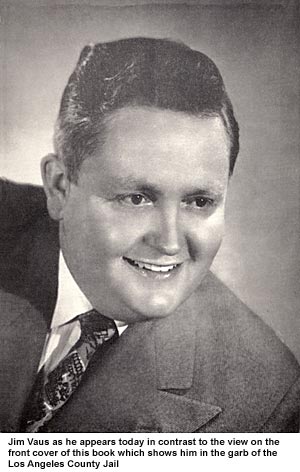
Who Were The Original Bug Sweepers?
Mickey Callahan Bernard Spindel Hal Lipset Jim Vaus

From the book "Cheesebox", the life of Mickey Cheesebox Callahan, page 118
Circa 1947-1953 New York City
"I had very good relations with Uncle Frank (Frank Costello, gangster) over the years. I charged him exorbitant fees for the smallest wirework and he always paid without a grumble. I got fistfuls of cash for checking Frank's phones and the phones of his partners and friends.
"I would go over the lines to his apartment on Central Park West several times a month, checking for taps. Sometimes I found them, sometimes not. When I did, he never got excited."
|

|
Comment: It appears that most wire tap inspections in those days were physical inspections for bridge taps, Callahan describes in another part of the book that he calls into the phone company posing as a technician and gets cable and pair routing information.
He does not mention any r.f. sweep tests and that's probably because with only tube amplifiers transmission bugs at that time were too large to hide.
|
|

|
 Hal Lipset
|
From the book " The Bug in the Martini Olive " Hal Lipset private eye, page 59
Circa 1964
"Perhaps as a result of so much publicity, clients arrived at Lipset Service asking Hal to do the reverse of what was making him locally famous -- to remove the bugs other investigators had planted in businesses, homes, and political meetings. Hal immediately dubbed this kind of work "industrial counterespionage," because the term sounded so professional, although the press would soon say that San Francisco's "super snooper" had now become a "super sweeper." "
Comment: In the next paragraph Hal discusses using a radio receiver with a frequency capability out to 30 MHZ, so by 1964 r.f. bugs had become a concern.
|
|

|

Bernard Spindel |
"Carl Ruh, who was a tester at the central telephone office at 228 East 56th Street, met Broady through Robert LaBorde. He and LaBorde went to work for Broady, providing him with pair and cable numbers and checking telephone lines for taps." (from page 85, New York, circa 1953)
|
|

|

|
Here is a quote from page 121 of "The Ominous Ear" by and about Bernard Spindel
Circa 1953
"In order to determine the full meaning and extent of this admonition, Hoffa employed me to assist him in several ways. First, he deemed it necessary to determine if his own telephone lines within the organization were being tapped. A physical inspection of Teamster Headquarters in Detroit disclosed that in June, 1953, there were seven active taps in operation. This number included the public telephone booth in the front lobby of the building. Upon the completion of this inspection, Hoffa discussed at length the various ways in which he might determine who in his organization was responsible for the accusations of 'shakedown' and coercion that were being leveled at the unions under his jurisdiction. We agreed to place a microphone - a completely legal procedure - in the offices of certain subordinates whom Hoffa deemed likely suspects. The first Teamster official tried and convicted for such illegal activity came to Hoffa's attention through the use of these microphones.
Hoffa also wanted to know if it would be possible to remove the existing wiretaps and what steps might be taken to prevent further wiretapping. My recommendation was to install a series of tap testers that would indicated the existence of the kinds of taps most commonly used. I also suggested locking the building's main telephone terminal-board room along with other junction points in an effort to prevent - or at least delay - outsiders from placing microphones in any of the organization's key offices."
Comment: It certainly would have been interesting to get a description of what a "tap tester" was back in 1953 but he does not make further mention of the subject. This book is well worth reading because this man was way ahead of his time and definitely a visionary. In the last chapter he warns about future government data bases crushing our privacy and freedom. Almost word for word the same warning made by William Safire last week on the overreach of homeland security and domestic spying. Spindel wrote his in 1968.
|
|

|

|
Jim Vaus in conversation with gangster Mickey Cohen, circa 1946-1949 (from pages 28-30):
"He ignored my little quip. 'If there were a microphone in my home, do you think you could locate it and take it out for me?'
"'Mr. Cohen, you've got me all wrong,' I objected. And believe me, at that moment, I had no intention of going to work for him. 'I'm in the business of putting them in, not of taking them out.'
"He stared at me, sizing me up. To him, every man had his price. What was mine? He reached in to his pocket and pulled out a roll of hundred-dollar bills, packed like a roll of film. For both size and value it was the biggest wad of money I'd ever seen. What I couldn't have done with it! With slow, deliberate motions he peeled a hundred-dollar bill off, then another and another. 'Vaus, are you still sure you don't take microphones out.'
"...Frankly, I didn't know what instruments it would take. But, I did like the feeling of those hundred-dollar bills in my pocket. After making arrangements with the household help to allow me in the following day, I went home. I would set up a microphone and then see if my instruments would indicate where it was. It was tedious and trying work, but finally I had equipment with which I dared try to find Mickey's.
"These microphones are difficult to find. They are very small, and are often buried between the two thicknesses of a wall. The wires that connect them are no larger than a human hair. Usually the wires are tucked into the cracks or crevices of the wood so that it is impossible to locate a microphone just by looking for it.
"...I used a high-gain amplifier and a pickup so sensitive it would pick up the radiation of a line through which a current was flowing, irrespective of its size.
"...After scuffling around under the house a few minutes I found the microphone, amplifier, wiring and a little hole about the size a termite would make, through which the wires were passed."
|
|


